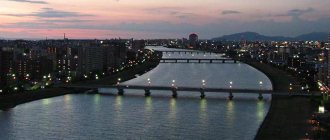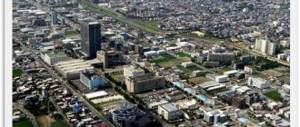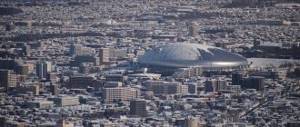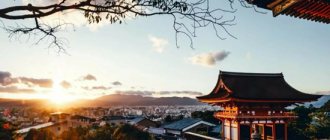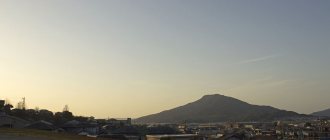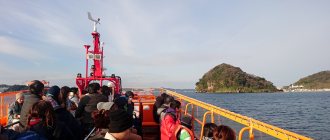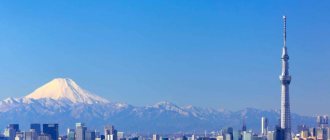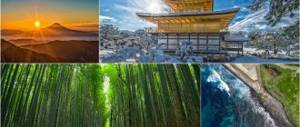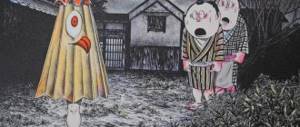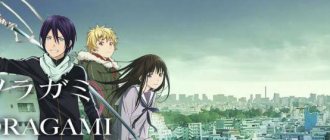Japan is one of the most unusual countries in the world. Consider the fact that at the beginning of the last century it was closed to the rest of the world (and even now it has strict morals), and now technological progress is raging here. As a result, many people have a desire to learn more about Japan or even go there on vacation.
Let's try to figure out why the Land of the Rising Sun deserves such close attention. It will be easier to do this by reading brief information about its location, political system, society and other important points.
Geography
Japan includes almost seven thousand islands. However, 97% of the area is occupied by the four largest of them - Honshu, Kyushu, Shikoku and Hokkaido.
Many islands have extinct and active volcanoes. Because of this, living there is not possible, so despite the total area of 388 thousand square kilometers, Japan has an acute shortage of areas for construction and agriculture.
The country is surrounded by water on all sides, so local residents have no shortage of seafood. At the same time, this location makes one fear tsunamis and earthquakes. Natural disasters are one of the main problems of the country, because they are almost impossible to prevent.
Interesting fact: The highest point in Japan is Mount Fuji (3776 meters).
Natural resources
The country demonstrates that rare example when neither the lack of natural resources nor modest agricultural opportunities stand in the way of the economic development of the state.
Japan's resource availability allows only 70% of its population to be supplied with food. Water, plant, fossil, and land resources are insufficient to create 100% self-sufficiency of the country.
Due to the mountainous terrain, forest resources are too limited, so annual artificial planting of vegetation helps to fill the missing potential.
Climate
According to Wikipedia, Japan has six climate zones. The Ryukyu Archipelago, for example, has a subtropical climate, the characteristic features of which are mild winters (one might say that they are absent here) and the presence of a rainy season.
The island of Hokkaido, in turn, surprises with an unprecedentedly small number of full sunny days (about 17-20 per year) and an average annual temperature of +8 degrees Celsius.
Thus, you can live both in cities with “eternal summer” and in regions where you cannot do without warm clothes. However, there is nowhere to hide from precipitation; there is a lot of it in Japan.
Interesting fact: Many people believe that the best time to visit Japan is the beginning of April - it is at this time that spring comes into its own and cherry blossoms begin to bloom everywhere.
Arrival of the first Europeans
Portuguese map of Japan.
Circa 1598 © robynbuntin.com
The first Europeans to set foot on Japanese soil were two Portuguese traders. On the 25th day of the 8th moon of the year 12 Tembun (1543), a Chinese junk with two Portuguese on board washed up at the southern tip of Tanegashima Island. Negotiations between the aliens and the Japanese were conducted in writing. Japanese officials knew how to write Chinese, but did not understand spoken language. The signs were drawn directly on the sand. It was possible to find out that the junk was accidentally washed up on the shores of Tanegashima by a storm, and these strange people were traders. Soon they were received at the residence of Prince Tokitaka, the ruler of the island. Among various strange things they brought muskets. The Portuguese demonstrated the capabilities of firearms. The Japanese were overwhelmed by the noise, smoke and firepower: the target was hit from a distance of 100 paces. Two muskets were immediately purchased, and Japanese blacksmiths were instructed to set up their own production of firearms. Already in 1544, there were several weapons workshops in Japan. Subsequently, contacts with Europeans became intense. In addition to weapons, they spread the Christian faith in the archipelago. In 1549, the Jesuit missionary Francis Xavier arrived in Japan. He and his students carried out active proselytizing activities and converted many Japanese princes - daimyo - to the Christian faith. The specifics of the Japanese religious consciousness presupposed a calm attitude towards faith. Adopting Christianity did not mean abandoning Buddhism and belief in Shinto deities. Subsequently, Christianity in Japan was banned under penalty of death, as it undermined the foundations of state power and led to unrest and uprisings against the shogunate.
1573
Population
The population of Japan in 2021 is 125 million 790 thousand people. But authorities are concerned that the death rate exceeds the birth rate, and young people are not eager to get married and have children.
According to the most pessimistic forecasts, by 2050 only 90 million people will live in the country. To prevent such developments, programs are being developed aimed at stimulating the growth of the birth rate.
At the same time, there are practically no refugees or migrants from other countries in Japan. Foreigners usually come here as tourists or on business trips, after which they return to their homeland.
Interesting fact: Japan is famous for its long-livers. Men here live on average 79 years, and women live 86 years.
Features of cities
It seemed to me that there is not enough space in Japan, and they are fighting for every piece of land there. But no. The first quick glance at the rice fields proved the opposite. There are mountains with untouched forests. That is, there is a lot of space. But it is precisely because of the mountains that the most convenient places to live are the bays. The population is distributed along the edges of the islands, with the largest number of people in Tokyo. The population and building density there is high.
If in Shanghai there were four-story interchanges and two-story roads, then feel free to add a floor here. Or better yet, two.
Without such a metro station map, it’s hard to get lost, because this is one of the smallest stations.
What they decided to sacrifice were cemeteries. They are very compact. Everything is cremated and clustered.
More production. Almost everything will be outsourced:
And look how such an obviously empty place as a river is used. Why does it just flow like that? Let's build a route over it. Or we'll make a stage there for performances. Or let the restaurant be:
In fact there are a lot of crowds. Queues, dense metro, attempts to squeeze even to the station in Vykhino (sorry, in Shinagawa) - it’s all there.
Specifically, there is such a crowd here, perhaps due to the fact that I came for the holidays of the change of emperor, which happen a couple of times a century.
Every time there were a lot of people around, my skill set acquired in China turned on. But this is the wrong set: you can’t touch anyone here and you don’t have to keep track of your things. Because they don't steal. At all. Well, that is, there were such cases, but no one personally encountered it. It is absolutely normal for girls to lay out their bags, phones and wallets on the tables in the food court of a shopping center, take a bill and go pay for ice cream across the hall. Or someone dropped their wallet, it lies on the street and waits for its owner:
In the evening, the owner of the store opposite will take it to the police. If no one contacts you within 3 months, you can keep the money. It turned out that simply observing things takes up a lot of resources in Russia. No paranoia about personal safety - this is happiness.
By the way, tickets to museums and other places do not spoil. Because most often you can log in again. Giving your ticket to someone else probably crossed someone’s mind, but if you break the law, it’s a shame for life.
The next thing that catches your eye is that a lot of people wear respirators. From ordinary gauze bandages to shaped masks.
Why? Comfortable. Protects from the sun. For allergies. Anonymously. Apparently, for the same reason, people almost never use credit cards (or it’s culturally determined) - in general, I hardly use them either, so everything is familiar.
The Japanese strictly follow the rules. They themselves form queues at stops and stand in them. This is law-abidingness mixed with politeness.
Judging by the strictness of the laws regarding the ability to obtain a SIM card, the government is actively monitoring your movements through the cellular network. Buying a SIM card for a foreigner is a difficult quest. It’s much easier to rent (at the airport they give you a 10-day rental right away without documents).
Solar panels are almost everywhere. From private ones you can download electricity back to the general network.
Separately, it is worth noting the toilets. As you may have guessed, Japanese toilets are very cold, just like everywhere else at home. But everywhere at home the Japanese wear outerwear, but here his ass is freezing. Therefore, when the first toilets were delivered, the engineers immediately equipped them with heating. And since it already has electrics, then you can finish off the rest - an analogue of a drinking fountain instead of toilet paper and other functions so that the toilet control panel resembles a spaceship control panel.
Yes, the bathtub and toilet are sold as modules and are simply inserted into the house, like we install shower stalls. And in Japan, a cubicle is just a container with a room and all communications in the walls, furniture and so on. All that remains is to supply water and food, everything else is already inside. Including a container for soap and shampoo if you ordered.
These are automatic machines. They are loved here, they sell a lot of things. By the way, an important point is that the prices in vending machines and in stores differ slightly. Even in tourist places. Even in a clean area of the airport.
Japanese society is now very old. Very much so, to the extent that other countries have never gone before. Because the average life expectancy is very high, and old people who should have stopped receiving pensions are still cheerful and cheerful. Here are WHO statistics for the Russian Federation - men live until 66, women until 77. Japan's report: add 15 years for every boy and 10 for every girl. However, I would not say that they are outright fans of medicine. They just do it on time. They eat without fanaticism. Without vaccinations, they won’t take you to school, before and after classes, schoolchildren always have sports, after 40 they send regular notices from hospitals “go for a preventive examination”, very expensive medicine (but insurance is an important part of the work contract). Lots of helipads for ambulances. By the way, the ambulance itself does not say “waaaaaaaaaaaaa”, but “waaaaaaaaaaaaaah, please give way, thanks in advance.” Because it's polite. And everyone else gives in because that's the rule. But it was important that they asked.
Mirn left a comment describing the medical examination here.
The last thing that struck me was this news about old people who volunteer to be liquidators of Fukushima. There is no sacrifice there, but ordinary rationalism. A 72-year-old grandfather confidently reports: he is already old, his life expectancy is 13 to 15 years, and cancer develops in 20-30. Therefore, even if you manage to grab a dose, it does not really matter.
Mail is sacred! Of all the postcards sent from different parts of the world, it was the Japanese ones that arrived the fastest.
Story
You can talk about the history of Japan for a very long time, but we will try to do it briefly, highlighting the most significant moments. It is believed that the islands that are part of the Japanese archipelago were inhabited about 42 thousand years ago. The ancient Japanese were engaged in hunting, fishing and gathering, but unlike the inhabitants of other regions, they did not lead a nomadic lifestyle. The reason is simple - the space for movement was limited by the area of a particular island.
The Japanese state in its modern form was formed in 250 AD. And by the middle of the millennium, Buddhism began to spread throughout the country, largely shaping the local culture, which has survived to this day almost in its original form.
But not everything was smooth sailing. The country had to go through both a period of feudal fragmentation and wars (first civil, and then with other countries).
The last turning point in the history of Japan at the moment can rightfully be considered the Second World War. It was brought to an end by the dropping of atomic bombs on Hiroshima and Nagasaki. After this, the authorities of the Land of the Rising Sun adopted capitulation, and a couple of years later, a pacifist constitution. Since then, Japan has gradually begun to increase its influence in the global economy, showing impressive growth in a variety of areas.
Interesting fact: The first European ship landed on the shores of the country in 1853, and it was from that moment that the relationship between Japan and the Western world began.
Japan's first permanent capital founded
View of the city of Nara.
1868 © East Asian Library - University of California, Berkeley
The development of statehood required the concentration of the court elite and the creation of a permanent capital. Until this time, each new ruler built himself a new residence. Staying in a palace desecrated by the death of the previous sovereign was considered dangerous. But in the 8th century, the model of a nomadic capital no longer corresponded to the scale of the state. The first permanent capital of Japan was the city of Nara. The place for its construction was chosen based on geomantic Geomancy, or Feng Shui, a method of orienting buildings in space, in which they were located in such a way as to receive the maximum amount of positive energy and get rid of the influence of negative energy. ideas about the security of space: a river must flow in the east, a pond and a plain in the south, roads in the west, mountains in the north. Based on these parameters of the enclosing landscape, sites will later be selected for the construction of not only cities, but also aristocratic estates. The city of Nara in plan was a rectangle with an area of 25 square kilometers and copied the structure of the Chinese capital Chang'an. Nine vertical and ten horizontal streets divided the space into blocks of equal area. The central avenue of Suzaku stretched from south to north and abutted the gates of the emperor's residence. Tenno - the title of the Japanese emperor - was also a designation for the North Star, located motionless in the north of the sky. Like the star, the emperor surveyed his possessions from the north of the capital. The neighborhoods adjacent to the palace complex had the greatest prestige; removal from the capital to the province could serve as a terrible punishment for an official.
769
Politic system
The political system of Japan is a constitutional monarchy. In other words, formally the leader of the country is the emperor, but in reality he has virtually no power. The emperor usually acts as an ambassador and symbol of the state, while all important decisions are made by the cabinet of ministers headed by the prime minister (this is the person who is actually the main one in the system).
The country also has a parliament, consisting of the House of Representatives (480 deputies) and the House of Councilors (282 deputies). Deputies to both houses are elected by the people, and they, in turn, choose the prime minister. Thus, ordinary people influence the political course of the country only indirectly.
The Social Democratic and Liberal Democratic parties have the largest number of seats in both houses of parliament. They fight for power with varying success.
Interesting fact: The position of emperor appeared in Japan in 660 BC and the dynasty has not been interrupted since then.
Agriculture
The territory of Japan is penetrated by many rivers and lakes that are not suitable for navigation. But they are skillfully used by the population to irrigate fields.
Fast-flowing rivers and other water resources support the hydroelectric industry, and lakes support the agricultural industry. Farmers mainly grow rice, legumes and tea.
Economy
Economic growth that began in Japan in the 50s of the last century allowed the country to become one of the leaders in the world economy. In terms of nominal GDP, Japan ranks third (right after the United States and China), and also has strong trade relations with a huge number of countries in different parts of the world.
Japan exports:
- Vehicles. Japanese-made cars and motorcycles are synonymous with the word “quality,” along with similar products from German concerns. Even people who are infinitely far from everything related to vehicles can easily recognize the logos of Toyota, Honda, Nissan and other local auto giants.
- Electronics. Look around and with a high degree of probability you will see something (phone, TV, refrigerator, etc.) from one of the Japanese manufacturers. Moreover, Japan is famous for its commitment to innovative technologies. It is no coincidence that robotics is very developed here. According to experts, within a few decades many people will be able to afford robotic assistants around the house. Robots will also replace employees in stores, banks, catering establishments and a number of other places.
- Seafood. Due to the ease of production, fish and other seafood are exported from the country in huge quantities. For Japanese cuisine restaurants, wherever they are located, it is considered very honorable to use ingredients delivered from the historical homeland of the dishes offered to guests.
Japan imports:
- Fossil fuel. An ever-growing economy requires large amounts of oil and coal, and Japan has always had problems with deposits of these minerals. The existing deposits have exhausted their resources, so fossil fuels have to be purchased in other countries. In the future, it is planned to abandon this through the use of alternative energy sources.
- Textile products. Fabrics, as well as finished products made from them (including clothing and shoes), are produced in the Land of the Rising Sun in insufficient quantities. In addition, local residents have a desire to buy products from foreign brands. Many companies even produce exclusive collections, especially for Japan.
- I'm going. Despite the presence of regions with a warm climate, the lack of free land does not allow Japan to become a major player in the agricultural market. The country faces a desperate shortage of grain and meat, which is met at the expense of foreign partners.
Interesting fact: According to Forbes, the list of the 2000 largest companies in the world includes 326 Japanese ones.
Completion of Japanese unification
Shogun Tokugawa Ieyasu.
1873 © Art Gallery of Greater Victoria
The founder of the third and last shogun dynasty in Japanese history was the commander Tokugawa Ieyasu. The title of Seiyi Taishogun was granted to him by the Emperor in 1603. The victory in the Battle of Sekigahara on October 21, 1600 allowed him to take the position of head of the Tokugawa military houses. All military houses that fought on the side of the Tokugawa began to be called fudai daimyo, and opponents - tozama daimyo. The first received possession of fertile lands and the opportunity to occupy government posts in the new shogunate. The possessions of the latter were confiscated and redistributed. Tozama daimyo were also deprived of the opportunity to take part in government, which led to dissatisfaction with the Tokugawa policies. It was those from among the Tozama daimyo who would become the main force in the anti-shogun coalition that would carry out the Meiji restoration in 1867–1868. The Battle of Sekigahara ended the unification of Japan and made possible the establishment of the Tokugawa shogunate.
1639
Middle Ages: Shoguns, Samurai and Isolation
In the Middle Ages, power leaves the weakened hands of the emperors and passes to the shoguns - military governors. The country of Japan is turning into a battle arena where powerful clans fight each other for the “keys to Kyoto.” Such a fragile system could not survive for long and soon collapsed, marking the advent of Sengoku Jidai - the era of the “warring states”.
After going through troubled times, Japan was finally united under the rule of Toyotomi Hideyoshi. Reluctance to contact the Europeans who entered the islands at the beginning of the 15th century led to the policy of “sakoku” - isolation.
Development of the “rule of law”
Heian period and Fujiwara reign
In the 8th century, the struggle for control of the central government between the aristocracy and Buddhist monks intensified.
The role of the royal house gradually declined. In this regard, in an effort to get rid of the influence of the Buddhists of the capital region of Nara, Emperor Kammu in 794 moved the capital of the country to the city of Heian - “the capital of peace and tranquility,” which eventually became known as Kyoto.
The period from the founding of this city until the formation of the first shogunate is called the Heian period (794–1185).
At the beginning of the 10th century, a shortage of state land began to appear, which is why the implementation of the “Law on the Granting of Land Allotments” slowed down. The imperial court changed course and transferred the collection of taxes to the shoulders of the provincial kokushi. The latter received a source of enrichment and appointed their own managers in the regions. At the same time, wealthy peasants began to leave state plots and raise virgin lands to turn them into private estates.
The state took a high tax on such estates, so their owners donated their property to powerful aristocrats and monasteries in order to pay less. In exchange for this, the new owners appointed the donors as stewards of their estates. In this way, a layer of new regional nobility was formed from peasants.
The emergence of the samurai and the insei institution
During the Heian period, due to the lack of internal or external threats to the central government, Japan did not have a regular army.
In general, the level of security in the country, especially in remote regions, was low. In order to protect their lands from robbers, the local nobility began to form armed detachments of “service people” - samurai. The leaders of such detachments were predominantly the capital's aristocrats, who were in a relationship of master and servant with their subordinate warriors. The most famous among the groups were people from the Taira and Minamoto clans.
Heian period culture
A new, original aristocratic culture of Kokufu emerged, which flourished during the reign of the Fujiwara family.
A new secular architectural style of palaces and estates with galleries and gardens appeared. The clothing of the nobility and townspeople acquired original Japanese forms. In fine art, a new genre of “Japanese paintings”, Yamato-e, arose, the main themes of which were the everyday life of nobles and local landscapes.
At the same time, the Japanese kana alphabet became widespread, and literary works began to be composed in it for the first time.
Frequent natural disasters, epidemics and instability in Japanese society in the mid-10th century gave rise to eschatological ideas. On this wave, the new Buddhist teaching of the Pure Land spread in the country, according to which anyone who prayed to Buddha Amida could go to heaven after death - “The Pure Land of incredible joy.”
The beginning of Japan's cultural blossoming
Map of Edo city.
1680 © East Asian Library - University of California, Berkeley
Under the reign of the Tokugawa shoguns, urban culture and entertainment flourished. A surge of creative activity occurred during the years of Genroku (1688–1704). At this time, the playwright Chikamatsu Monzaemon, who later received the nickname “Japanese Shakespeare,” the poet Matsuo Basho, a reformer of the haiku genre, as well as the writer Ihara Saikaku, nicknamed by Europeans the “Japanese Boccaccio,” created his works. Saikaku's works were secular in nature and described the everyday life of townspeople, often in a humorous manner. The Genroku years are considered the golden age of kabuki theater and bunraku puppet theater. At this time, not only literature, but also crafts were actively developing.
